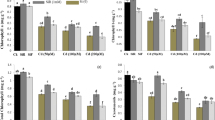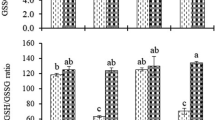Abstract
Chromium (Cr) is a toxic metal usually found in soil and water, causing environmental pollution. Silicon (Si), however, has excelled in alleviating the stress caused by toxic elements in plants, and its beneficial role was mainly based on external and internal plant mechanisms. This study investigates whether and how Si influences the alleviation of Cr toxicity in wheat at the physiological and biochemical levels. The addition of Si in Cr-stressed plants significantly improved morpho-physiological characteristics, total protein, and membrane stability compared to Cr-stressed plants, suggesting that Si does have critical roles in Cr detoxification in wheat. Furthermore, Si supplementation in Cr-stressed plants showed a significant increase of Cr in roots but not in shoots compared with the plants grown under Cr stress. The addition of Si in Cr stress the raised the total chlorophyll (a and b) compared to non-treated controls. Beside this, abiotic stress indicators, such as cell death, electrolyte leakage and total soluble protein remarkably improved subjected to Si under Cr stress. These improvements are in accordance with the significant decrease of Cr in both root and shoot due to Si under Cr stress. Furthermore, Si application enhanced non-enzymatic scavenging and proline concentration to reduce Cr-induced oxidative damage in wheat. These findings reveal the role of Si on Cr detoxification in wheat and can be further implemented as a fertilization strategy.
Zusammenfassung
Chrom (Cr) ist ein giftiges Metall, das im Boden und Wasser vorkommt und die Umwelt verschmutzt. Silizium (Si) hat sich allerdings bei der Reduzierung des durch toxische Elemente verursachten Stresses in Pflanzen bewährt, und seine vorteilhafte Rolle beruhte hauptsächlich auf externen und internen Pflanzenmechanismen. In dieser Studie wird untersucht, ob und wie Si die Linderung der Cr-Toxizität in Weizen auf physiologischer und biochemischer Ebene beeinflusst. Die Zugabe von Si in Cr-gestressten Pflanzen verbesserte die morpho-physiologischen Eigenschaften, den Gesamtproteingehalt und die Membranstabilität im Vergleich zu Cr-gestressten Pflanzen signifikant, was darauf hindeutet, dass Si bei der Cr-Entgiftung von Weizen eine entscheidende Rolle spielt. Darüber hinaus zeigte die Si-Zugabe bei Cr-gestressten Pflanzen im Vergleich zu den unter Cr-Stress gezüchteten Pflanzen einen signifikanten Anstieg von Cr in Wurzeln, aber nicht in Trieben. Die Zugabe von Si bei Cr-Stress erhöhte das Gesamtchlorophyll (a und b) im Vergleich zu unbehandelten Kontrollen. Darüber hinaus verbesserten sich die abiotischen Stressindikatoren, wie Zelltod, Elektrolytverlust und die gesamten löslichen Proteine, unter der Einwirkung von Si unter Cr-Stress bemerkenswert. Diese Verbesserungen stehen im Einklang mit der signifikanten Abnahme von Cr sowohl in der Wurzel als auch im Spross aufgrund von Si unter Cr-Belastung. Darüber hinaus erhöhte die Si-Anwendung das nicht-enzymatische Scavenging und die Prolinkonzentration, um den Cr-induzierten oxidativen Schaden in Weizen zu reduzieren. Diese Ergebnisse verdeutlichen die Rolle von Si bei der Entgiftung von Cr in Weizen und können in Düngungsstrategien weiter umgesetzt werden.




Similar content being viewed by others
References
Ali H, Khan E, Sajad MA (2013) Phytoremediation of heavy metals—concepts and applications. Chemosphere 7:869–881
Begum MC, Islam MS, Islam M, Amin R, Pavez MS, Kabir AH (2016) Biochemical and molecular responses underlying differential arsenic tolerance in rice (Oryza sativa L.). Plant Physiol Biochem 104:266–277
Datta JK, Bandhyopadhyay A, Banerjee A, Mondal NK (2011) Phytotoxic effect of chromium on the germination, seedling growth of some wheat (Triticum aestivum L.) cultivars under laboratory condition. J Agric Technol 7:395–402
Davies F, Puryear T, Newton R, Egilla J, Grossi J (2002) Mycorrhizal fungi increase chromium uptake by sunflower plants: influence on tissue mineral concentration, growth and gas exchange. J Plant Nutr 25:2389–2407
Dixit V, Pandey V, Shyam R (2002) Chromium ions inactivate electron transport and enhance superoxide generation in vivo in pea (Pisum sativum L. cv. Azad) root mitochondria. Plant Cell Environ 25:687–693
Gao Y, Miao C, Xia J, Mao L, Wan Y, Zhou P (2010) Plant diversity reduce the effect of multiple heavy metal pollution on soil enzyme activities and microbial community structure. Front Environ Sci Eng 6:213–223
Goto M, Ehara H, Karita S, Takabe K, Ogawa N, Yamada Y, Ogawa S, Yahaya MS, Morita O (2003) Protective effect of silicon on phenolic biosynthesis and ultraviolet spectral stress in rice crop. Plant Sci 164:349–356
Greger M, Landberg T (2008) Influence of silicon on cadmium in wheat. In: Laing M (ed) 4th International Conference on Silicon in Agriculture. Aim Print Durban, Wild Coast Sun, South Africa, p 25
Greger M, Kabir AH, Maity PJ, Landberg T, Lindberg S (2016) Silicate reduces cadmium uptake into cells of wheat. Environ Poll 211:90–97
Guy C, Haskell D, Neven L, Klein P, Smelser C (1992) Hydration-state-responsive proteins link cold and drought stress in spinach. Planta 188:265–270
Hayat S, Khalique G, Irfan M, Wani AS, Tripathi BN, Ahmad A (2012) Physiological changes induced by chromium stress in plants: an overview. Protoplasma 249:599–611
Hoagland DR, Arnon DI (1950) The water-culture method for growing plants without soil. Circular. Cali Agric Exp Stat, vol 347. University of California, Berkeley, p 32
Kabir AH, Hossain MM, Khatun MA, Mandal A, Haider SA (2016) Role of silicon counteracting cadmium toxicity in Alfalfa (Medicago sativa L.). Front Plant Sci 7:1117
Koleli N, Eker S, Cakmak I (2004) Effect of zinc supply on cadmium toxicity in durum and bread wheat grown in zinc deficient soil. Environ Pollut 131:453–459
Lichtenthaler HK, Wellburn AR (1985) Determination of total carotenoids and chlorophylls a and b of leaf in different solvents. Biochem Soc Trans 11:591–592
Lindberg S, Landberg T, Greger M (2007) Cadmium uptake and induction of phytochelatins in wheat protoplasts. Plant Physiol Biochem 45:47–87
Ling HQ, Bauer P, Bereczky Z, Keller B, Ganal M (2002) The tomato fer gene encoding a b HLH protein controls iron-uptake responses in roots. Proc Natl Acad Sci U S A 99:13938–13943
Liu D, Jiang W, Li M (1992) Effects of trivalent and hexavalent chromium on root growth and cell division of Allium cepa. Hereditas 117:23–29
Liu J, Duan C, Zhang X, Zhu Y, Lu X (2013) Potential of Leersia hexandra Swartz for phytoextraction of Cr from soil. J Hazard Mater 88:85–91
Lopez-Luna J, Gonzalez-Chavez MC, Esparza-Garcia FJ, Rodriguez-Vazquez R (2009) Toxicity assessment of soil amended with tannery sludge, trivalent chromium and hexavalent chromium, using wheat, oat and sorghum plants. J Hazard Mater 163:829–834
Lutts S, Kinet JM, Bouharmont J (1996) NaCl-induced senescence in leaves of rice (Oryza sativa L.) cultivar differing in salinity resistance. Ann Bot 78:389–398
Ma JF, Yamaji N, Mitani N, Xu XX, Su YH, McGrath SP, Zhao FJ (2008) Transporters of arsenite in rice and their role in arsenic accumulation in rice grain. PNAS 105:99319935
Panda SK, Mahapatra S, Patra HK (2002) Chromium toxicity and water stress simulation effects in intact senescing leaves of greengram (Vigna radiata L.var Wilckzeck K851). In: Panda SK (ed) Advances in Stress physiology of plants, Scientific Publishers, India, pp 129–136
Roberts JR (1999) Metal toxicity in children. In: Emercyulle GA (ed) Training manual on pediatric environmental health: putting it into practice. Children’s Environmental Health Network, United States
Rogalla H, Romheld V (2002) Role of leaf apoplast in siliconmediated manganese tolerance of Cucumis sativus L. Plant Cell Environ 25:549–555
Schiavon M, Wirtz M, Borsa P, Quaggiotti S, Hell R, Malagoli M (2007) Chromate differentially affects the expression of a high-affinity sulfate transporter and isoforms of components of the sulfate assimilatory pathway in Zea mays (L.). Plant Biol 9:662–671
Shanker AK, Cervantes C, Loza-Tavera H, Avudainayagam S (2005) Chromium toxicity in plants. Environ Int 31:739–753
Singh HP, Mahajan P, Kaur S, Batish DR, Kohli RK (2013) Chromium toxicity and tolerance in plants. J Environ Chem Lett 11:229–254
Stolt JP, Sneller T, Bryngelsson T, Lundborg H (2003) Phytochelatin and cadmium accumulation in wheat. Environ Exp Bot 49:21–28
Tripathi DK, Singh VP, Kumar D, Chauhan DK (2012) Impact of exogenous silicon addition on chromium uptake, growth, mineral elements, oxidative stress, antioxidant capacity, and leaf and root structures in rice seedlings exposed to hexavalent chromium. Acta Physiol Plant 34:279–289
Vajpayee P, Tripathi RD, Rai UN, Ali MB, Singh SN (2000) Chromium (VI) accumulation reduces chlorophyll biosynthesis, nitrate reductase activity and protein content in Nymphaea alba L. Chemosphere. 41:1075–1082
Zhang C, Wang L, Nie Q, Zhang W, Zhang F (2008) Long-term effects of exogenous silicon on cadmium translocation and toxicity in rice (Oryza sativa L.). Environ Exp Bot 62:300–307
Zhao J, Fujita K, Sakai K (2005) Oxidative stress in plant cell culture: a role in production of β‑thujaplicin by Cupresssus lusitanica suspension culture. Biotechnol Bioeng 90:621–631
Author information
Authors and Affiliations
Corresponding author
Ethics declarations
Conflict of interest
U. Sarkar, S. Tahura, U. Das, M.R. Amin Mintu and A. Humayan Kabir declare that they have no competing interests.
Rights and permissions
About this article
Cite this article
Sarkar, U., Tahura, S., Das, U. et al. Mitigation of Chromium Toxicity in Wheat (Triticum aestivum L.) Through Silicon. Gesunde Pflanzen 72, 237–244 (2020). https://doi.org/10.1007/s10343-020-00506-6
Received:
Accepted:
Published:
Issue Date:
DOI: https://doi.org/10.1007/s10343-020-00506-6




